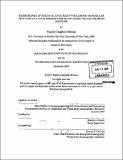Biomechanics of North Atlantic right whale bone : mandibular fracture as a fatal endpoint for blunt vessel-whale collision modeling
Author(s)
Campbell-Malone, Regina P
DownloadFull printable version (44.72Mb)
Alternative title
Mandibular fracture as a fatal endpoint for blunt vessel-whale collision modeling
Other Contributors
Woods Hole Oceanographic Institution.
Advisor
Michael J. Moore.
Terms of use
Metadata
Show full item recordAbstract
The North Atlantic right whale, Eubalaena glacialis, one of the most critically endangered whales in the world, is subject to high anthropogenic mortality. Vessel-whale collisions and entanglement in fishing gear were indicated in 27 (67.5%) of the 40 right whales necropsied between 1970 and December 2006. Of those, at least 9 deaths (22.5%) resulted from blunt contact with a vessel. To reduce the likelihood of fatal collisions, speed restrictions are being considered for vessels traversing critical habitat, although the effects of speed on collision outcomes have not been specifically evaluated from a biomechanics perspective. The ultimate goal of a larger collaborative project is to evaluate the efficacy of speed restrictions for reducing blunt collision mortality using a multi-scale finite element model. Complete, transverse fracture of the right whale mandible, an injury seen only in right whales killed by vessels, is used as a proxy for mortality in the model. Vital for that model are the material properties and biomechanical behavior of the right whale mandible. Here, the internal structure and physical properties of right whale jawbone tissue are reported. The average apparent densities, 0.4258 g/cc ±0.0970 and 1.2370 g/cc ±0.0535 for trabecular and cortical bone respectively, indicate that the bone is of relatively low density. Average ash content for trabecular bone (64.38% ±1.1330) is comparable with values from other species, indicating that low density results from a reduction of bone mass, not mineralization. Mechanical properties of right whale bone (Young's modulus of elasticity and Poisson's ratio) were determined via uniaxial compression testing. (cont.) These data are incorporated into the finite element model simulating different loading conditions (e.g. vessel speeds) that likely lead to mandibular failure and thereby mortality from blunt vessel collisions. Model results (e.g. risk of fracture) are used to determine the effect of speed restrictions on collision outcomes.
Description
Thesis (Ph. D.)--Joint Program in Oceanography/Applied Ocean Science and Engineering (Massachusetts Institute of Technology, Dept. of Biology; and the Woods Hole Oceanographic Institution), 2007. Includes bibliographical references.
Date issued
2007Department
Joint Program in Oceanography/Applied Ocean Science and Engineering; Woods Hole Oceanographic Institution; Massachusetts Institute of Technology. Department of BiologyPublisher
Massachusetts Institute of Technology
Keywords
/Woods Hole Oceanographic Institution. Joint Program in Oceanography/Applied Ocean Science and Engineering., Biology., Woods Hole Oceanographic Institution.